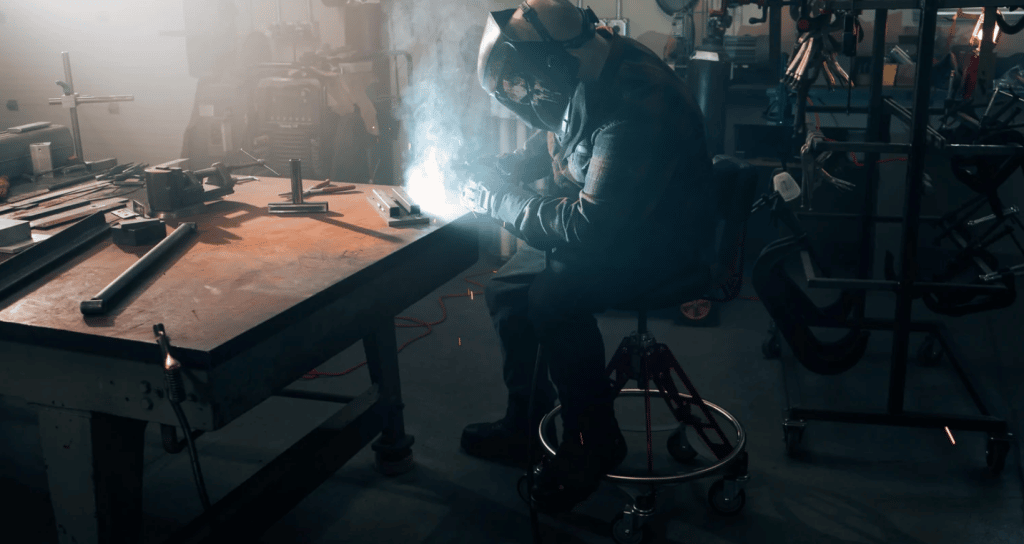It is because our bodies aren’t very good conductors of electricity when compared with the metals that we weld with. It is because of this fact that weld cables are made of such a thick material in order to ensure that no electric shock will occur to the welder. That is why the current always chooses the easiest path to flow.

190 Cases
Considered
180 Hours of Research
32 Experts Interviewed
250 Studies
Analyzed
As a rule, current will always follow the path of least resistance. This is either through the ground clamp you secure to the workpiece, or another conductor that the workpiece is touching. A disconnect from this ground clamp would stop the circuit from working, so you would not be able to weld (or start to weld).
Certainly there is a risk of electrocution if you are welding in wet conditions, or if you have provided a path to ground (such as touching the electrode with a ground clamp while holding the ground clamp) then there is a risk of electrocution.
While it is always important to provide a safe path to ground, you should never clamp to oxidised/painted metal and do not weld in wet conditions. There are mainly a number of risks associated with welding that include burns, corneal inflammation, and retinal burning due to the UV rays generated by the arc.
How Likely Is It To Receive A Shock When Welding?
Electricity always follows the path with the least amount of resistance. If you are dry and standing on a dry surface, your body has a higher electrical resistance than the metals you deal with.
Through the base metals and back through the ground cable, electricity finds less resistance than through you. However, if you are the lone conductor in an electrical circuit, it is possible that you may suffer an electric shock.
It is possible to obtain an electrical shock while welding. Particularly if you, your hands, clothing, the floor, or the metals you’re attempting to weld are damp.
NOTE: Avoid welding in the rain or snow at all times. Ensure that there are no sources of water or liquids that could come into touch with you when welding, and that you are wearing dry welding gloves and clothing.
Here are my ideas for protective welding gloves of superior quality:

- Extra thumb patch
- Trapezoidal thumb shape
- Reinforced finger
- Sewn with Kevlar
- External material: goatskin
- Kevlar lining
- Cutting proof

- Good cuff length
- External material: goatskin
- Kevlar lining
- Kevlar stitching
- Cowhide cuffs
- Cut resistant
- Heat resistant all over and direct touch
Even perspiration can and will enhance the likelihood of obtaining an electric shock. Water is not inherently an excellent conductor of electricity, but it has considerably less resistance than you do.
In addition, to prevent electrical shock, you should never contact the electrode, metal portions of the electrode holder, or any exposed wire connecting the electrode holder to the machine.
Avoid welding on metal floors such as grating or scaffolding. promptly replace any broken electrode holders.
Examine Welding Leads to Decrease Potential Shock Danger

Before each task, inspect both leads from the point where they leave the machine to their respective ends to further decrease the risk of shock. At the first sign of old, fractured, or missing insulation, replace the leads.
Replace damaged welding handles, electrode holders, and ground lead clamps immediately.
Disconnect The Welding Machine
Repairing a welding equipment or changing the wire spools on a MIG welder may expose you to a higher voltage and current than welding itself. It is necessary to totally turn off the machine and disconnect it.
Unplugging the device is the only way to assure that no electricity remains within the device. Turning off the switch only deactivates the leads. When the machine is connected in, it should always be assumed to be operational.
In a welding equipment, the current will always be AC or alternating current.
Is It Necessary to Unplug The MIG Welder When Changing The Spools Or Polarity?

Before changing the spools or polarity on a MIG welder, the spool access door must be opened with the power cord disconnected. Follow the instructions for your machine to accurately feed the wire through the wire feeder while changing the spool.
Then, shut the access door prior to plugging in the welder. Pull the trigger until the new wire passes through the tip of the welding handle.
NOTE: If you simply moved from flux core wire to MIG wire, for instance, you may also need to adjust the polarity within the welder. Unplug the welder before opening the access door and continue to follow the instructions. Always close the access door before re-plugging the machine after changing the polarity.
Place the welding machine in a secure, dry location. Connect the welder to a circuit with the load-appropriate breaker installed.
DC or AC Welding: Which Is More Dangerous?
Generally speaking, DC welding may be safer than AC welding. Due to the quick switching of polarity caused by alternating current, DC is less likely to stop your heart if you are shocked than alternating current.
50 milliamperes are sufficient to cause death. Alternating current is more likely to prevent you from releasing the electricity source if you have a grip on it at the moment of the shock. This is because your muscles contract when you are shocked with alternating current.
Even if it may not immediately cause death, a shock can cause a person to fall. Depending on your location and position at the time of the fall, the fall itself may be hazardous or lethal. In addition to burns and nerve damage, other potential injuries from receiving an electric shock are burns and nerve damage.
What Should You Do If You Experience An Electrical Shock While Welding?
Electrical burns can inflict significant damage. Nonetheless, severity is not often readily apparent.
After turning off the power, contact emergency medical personnel immediately. First aid may include cardiopulmonary resuscitation, treatment for shock, and cleaning burns with clean water before applying a clean bandage.
How Many Individuals Are Wounded Annually While Welding?
Electrical shock deaths while welding are uncommon. In 2022, the Bureau of Labor Statistics recorded less than 50 deaths from all causes among metal workers. Several times in my own life, I have been surprised.
I was once coated in snow and runoff while welding outdoors. I was fortunate if the shock was mild, but it did get my attention. Enough so that I let a few days to pass before resuming work on the project.
Consequently, enjoy learning to weld. It can be very profitable and secure. Simply adhere to a few simple rules. Never forget that, like with any task involving tools and machines, a serious accident is imminent if you fail to observe fundamental safety procedures.
Best Practice
Keep dry – don’t weld outdoors in the rain – wear thick working clothes, boots, and gloves – if your gloves get wet, wear rubber gloves inside them – protect welding leads from sharp edges – always have a clean earth to the work – clean off paint and rust under the earth clamp grips – acquire a real earth clamp – if you are welding outdoors in the rain, make sure the welder is also earthed to ground.
Conclusion
If you are welding while standing in a pool of water, you can be electrocuted due to the low resistance path to ground. Welding on a ship is hazardous for this reason, particularly if performed in the bilge, within a tank, or especially inside the double bottom – the most hazardous location.
Due to the danger, a company with its own welders will occasionally subcontract the welding tasks inside the double bottom.
Inside, there are hazardous fume exposures and the possibility of electrocution; nevertheless, you have a friend with a rope attached to your legs who will pull you out of danger.
Obviously, this is a poor practise by the maintenance company, but such is life. Someone I know was electrocuted inside a ship’s twin bottom yet escaped unharmed.
